Improves the uncomfortable swaying and walking feeling of steel stairs! The ultra-thin vibration-damping device Floormate reduces vibration without compromising the design of the staircase.

Steel staircases can be stylishly designed with slim components. On the other hand, vibration during walking can be a problem. Do you want to make your staircase less prone to swaying without changing the design? Yacmo's thin vibration-damping device "Floormate" is the best solution.
issue
A steel staircase is a staircase that uses steel for its structural members. The staircase can maintain its strength even when it is made of slim members, and it can create an open space with a stylish design that allows a high degree of freedom. On the other hand, they are relatively prone to vibration, which can cause discomfort when swaying or walking.
In the planning of Company Y's new building, a steel staircase was planned to be installed in the indoor atrium area. The staircase was to be installed in the 11-meter beam span between the 4th and 3rd floors of the building, with no pillars or other supports, to create an open atrium space (Fig. 1). The designers were concerned that the structural analysis of the staircase would cause significant vibration when ascending and descending, but they wanted to keep the design as it was.
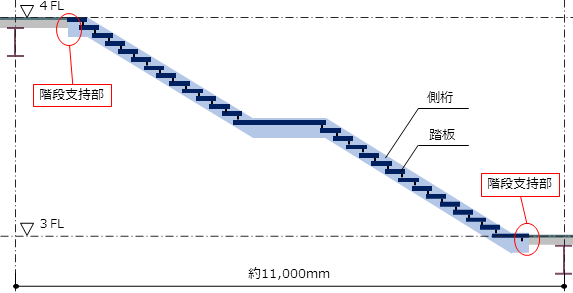
Figure 1: Cross-sectional image of staircase
counter-measure
Without changing the girders or adding supports, we decided to install an ultra-thin vibration control device, Floor Mate (Figure 2, Table 1), which can be installed on the back side of the landing without damaging the design of the staircase. Floor Mate is a TMD (Tuned Mass Damper) type vibration control device, and is extremely thin (44 mm thick) and can be installed on stair treads, behind landings, and under OA floors.
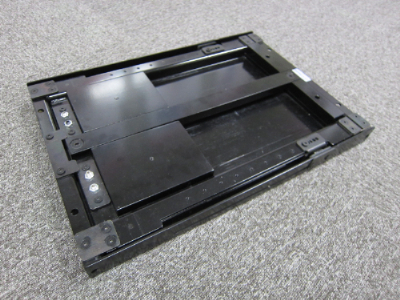
Figure 2: Appearance of the vibration control device Floor Mate
Table 1: Basic Specifications of Vibration Damping Equipment
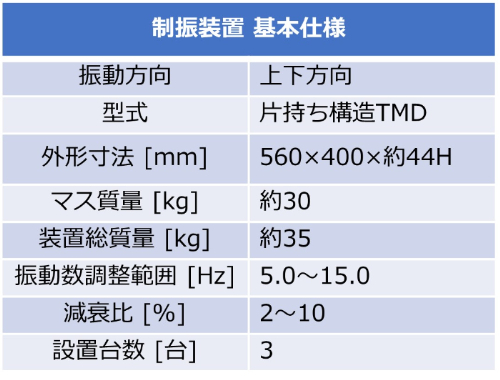
A TMD type vibration control device such as FLOORMATE requires that the natural frequency of the TMD mass be in tune with the frequency at which the object to be vibration controlled tends to sway (natural frequency). To determine the natural frequency of the staircase, we first measured the response acceleration by manually shaking the staircase (heel shaking). As shown in Figure 3, we found that the natural frequency of the staircase peaked at 6.5 Hz.
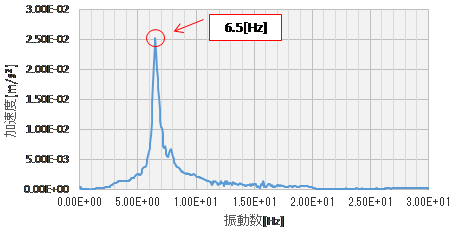
Figure 3: Results of FFT analysis during heel excitation
After adjusting the frequency of the vibration control device to match the natural frequency of the staircase, it was installed behind the staircase (landing) (Figure 4).

Figure 4: Installation of vibration control equipment (left: before installation, right: after installation)
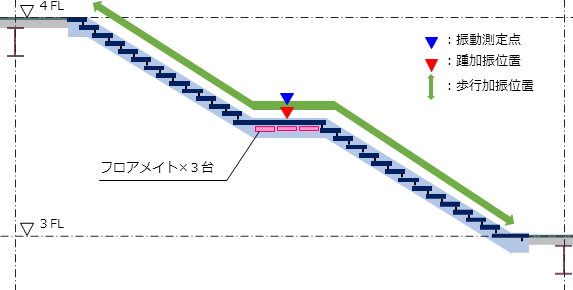
Figure 5: Measurement location diagram and Floor Mate installation location diagram
result
After installation of the floor mate, measurements were taken to confirm the effect of the floor mate by one person walking in the non vibration control (TMD OFF) and vibration control (TMD ON) conditions. The results are shown in Figure 6. In the non-vibration-control condition, the vibration was 22.2 cm/s in the 1/3-octave band at 6.3 Hz.2After vibration control, the vibration was 10.6 cm/s.2and has been reduced to about 1/2. Figure 6 shows the evaluation curve for vibration, the occupant performance evaluation curve※ 1and pedestrian bridge guidelines※2In this case, since the subject is a staircase and not a living space, vibration evaluation is based on the latter (Table 2). As shown in Table 2, the vibration control system reduced the vibration from "slightly felt" to "less than slightly felt" for those who were walking, and from "clearly felt" to "slightly felt" for those who were standing still, confirming that the Floor Mate improved the swaying when ascending and descending.
*1 "AIJES-V0001-2004, Environmental Standard of the Architectural Institute of Japan, Guideline for Occupant Performance Evaluation of Building Vibration and its Commentary".
2 "Pedestrian Bridges in the Future - Guidelines for Planning and Design of Pedestrian Bridges that are Attached and People-Friendly" Japan Steel Construction Association, ed.

Figure 6: Measured results of effectiveness confirmation by one person walking (occupant performance evaluation curve and pedestrian bridge design guidelines)
Table 2: Comparison of evaluation before and after vibration control using pedestrian bridge design guidelines

Related Pages
- Product Information] Floor Mate
- Case Study] Ultra-thin size that can be hidden in the treads! Floor Mate is useful for vibration control of design stairs
Related Content
- Yacmo's Vibration Prevention Map by Usage Scenario
- Product Service Documents] Resolve your TMD questions! Frequently Asked Questions Q&A
- Technical Column] Vibration Countermeasures for Steel Stairs
- Technical Column] Types and Features of Measures to Reduce Floor Swaying Caused by Walking and Machinery
- Product Drawing] Floor Mate CAD data (dwg,dxf)
